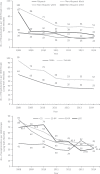Hospitalization Trends and Comorbidities Among People With HIV/AIDS Compared With the Overall Hospitalized Population, Illinois, 2008-2014
- PMID: 29913100
- PMCID: PMC6055283
- DOI: 10.1177/0033354918777254
Hospitalization Trends and Comorbidities Among People With HIV/AIDS Compared With the Overall Hospitalized Population, Illinois, 2008-2014
Abstract
Objectives: To understand trends in health care use among people living with HIV/AIDS (PLWHA), this study compared trends in hospitalization rates, comorbidities, and hospital death rates of hospitalized PLWHA with the overall hospitalized population in Illinois during 2008-2014.
Methods: This study identified principal hospitalizations (the principal discharge diagnosis coded with an HIV-related billing code) and secondary HIV hospitalizations (a non-principal discharge diagnosis coded with an HIV-related billing code) from 2008-2014 Illinois hospital discharge data. Hospitalization rates among PLWHA were calculated using prevalence data from the Illinois Electronic HIV/AIDS Registry; US Census population estimates were used to calculate overall Illinois hospitalization rates. Joinpoint regression analysis was used to assess trends overall and among demographic subgroups. Comorbidities and discharge status for all hospitalizations were identified.
Results: In 2014, the hospitalization rate was 2.2 times higher among PLWHA than among the overall Illinois hospitalized population. From 2008 to 2014, principal HIV hospitalization rates per 1000 PLWHA decreased by 48% (from 71 to 37) and secondary HIV hospitalization rates declined by 26% (from 296 to 218). The decline in the principal HIV hospitalization rate was steepest from 2008 to 2011 (annual percentage change = -16.0%; P = .003). Mood disorders, substance-related diagnoses, and schizophrenia accounted for 18% to 22% of principal hospitalizations among PLWHA compared with 7% to 8% of overall Illinois hospitalizations. Hepatitis as a comorbidity was more common among hospitalized PLWHA (18%-22%) than among the overall Illinois hospitalized population (1.4%-1.5%). Hospitalized PLWHA were 3 times more likely than the overall Illinois hospitalized population to die while hospitalized.
Conclusions: HIV hospitalizations are largely preventable with appropriate treatment and adherence. Additional efforts to improve retention in HIV care that address comorbidities of PLWHA are needed.
Keywords: HIV/AIDS; comorbidities; disparities; hospitalization; mental health.
Conflict of interest statement
Figures


References
-
- Centers for Disease Control and Prevention. Diagnoses of HIV infection in the United States and dependent areas, 2015. HIV Surveill Rep. 2016;27:1–114. http://www.cdc.gov/hiv/library/reports/hiv-surveillance.html. Accessed May 13, 2018.
-
- Illinois Department of Public Health, Office of Health Protection, HIV/AIDS Section. Illinois integrated HIV prevention and care plan 2017-2021: a roadmap for collective action in Illinois. 2016. http://www.dph.illinois.gov/sites/default/files/publications/publication.... Accessed May 13, 2018.
-
- US Government. Patient Protection and Affordable Care Act, Pub L No. 111-148, as amended by the Health Care and Education Reconciliation Act, Pub. L No. 111-152 (2010).
Publication types
MeSH terms
LinkOut - more resources
Full Text Sources
Other Literature Sources
Medical

